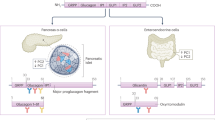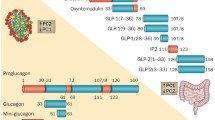Abstract
The regulation of plasma amino acid levels by glucagon in humans first attracted the attention of researchers in the 1980s. Recent basic research using animal models of glucagon deficiency suggested that a major physiological role of glucagon is the regulation of amino acid metabolism rather than to increase blood glucose levels. In this regard, novel feedback regulatory mechanisms that are mediated by glucagon and amino acids have recently been described between islet alpha cells and the liver. Increasingly, hyperglucagonemia in humans with diabetes and/or nonalcoholic fatty liver diseases is reported to likely be a compensatory response to hepatic glucagon resistance. Severe glucagon resistance due to a glucagon receptor mutation in humans causes hyperaminoacidemia and islet alpha cell expansion combined with pancreatic hypertrophy. Notably, a recent report showed that the restoration of glucagon resistance by liver transplantation resolved not only hyperglucagonemia, but also pancreatic hypertrophy and other metabolic disorders. The mechanisms that regulate islet cell proliferation by amino acids largely remain unelucidated. Clarification of such mechanisms will increase our understanding of the pathophysiology of diseases related to glucagon.
Similar content being viewed by others
References
Kimball CP, Murlin JR. Aqueous extracts of pancreas. III. Some precipitation reactions of insulin. J Biol Chem. 1923;58(1):337–46.
Mallinson CN, Bloom SR, Warin AP, Salmon PR, Cox B. A glucagonoma syndrome. Lancet. 1974;2(7871):1–5. https://doi.org/10.1016/s0140-6736(74)91343-9.
Unger RH, Ohneda A, Aguilar-Parada E, Eisentraut AM. The role of aminogenic glucagon secretion in blood glucose homeostasis. J Clin Invest. 1969;48(5):810–22. https://doi.org/10.1172/JCI106039.
Boden G, Master RW, Rezvani I, Palmer JP, Lobe TE, Owen OE. Glucagon deficiency and hyperaminoacidemia after total pancreatectomy. J Clin Investig. 1980;65(3):706–16. https://doi.org/10.1172/jci109717.
Boden G, Rezvani I, Owen OE. Effects of glucagon on plasma amino-acids. J Clin Investig. 1984;73(3):785–93. https://doi.org/10.1172/jci111272.
Furuta M, Yano H, Zhou A, Rouille Y, Holst JJ, Carroll R, et al. Defective prohormone processing and altered pancreatic islet morphology in mice lacking active SPC2. Proc Natl Acad Sci USA. 1997;94(13):6646–51. https://doi.org/10.1073/pnas.94.13.6646.
Gelling RW, Du XQ, Dichmann DS, Romer J, Huang H, Cui L, et al. Lower blood glucose, hyperglucagonemia, and pancreatic alpha cell hyperplasia in glucagon receptor knockout mice. Proc Natl Acad Sci USA. 2003;100(3):1438–43. https://doi.org/10.1073/pnas.0237106100.
Lee Y, Wang M-Y, Du XQ, Charron MJ, Unger RH. Glucagon receptor knockout prevents insulin-deficient type 1 diabetes in mice. Diabetes. 2011;60(2):391–7. https://doi.org/10.2337/db10-0426.
Unger RH, Cherrington AD. Glucagonocentric restructuring of diabetes: a pathophysiologic and therapeutic makeover. J Clin Investig. 2012;122(1):4–12. https://doi.org/10.1172/jci60016.
Unger RH, Eisentraut AM, Mc CM, Madison LL. Glucagon antibodies and an immunoassay for glucagon. J Clin Invest. 1961;40(7):1280–9. https://doi.org/10.1172/JCI104357.
Jun LS, Millican RL, Hawkins ED, Konkol DL, Showalter AD, Christe ME, et al. Absence of glucagon and insulin action reveals a role for the GLP-1 receptor in endogenous glucose production. Diabetes. 2015;64(3):819–27. https://doi.org/10.2337/db14-1052.
Gagnon J, Mayne J, Chen A, Raymond A, Woulfe J, Mbikay M, Chretien M. PCSK2-null mice exhibit delayed intestinal motility, reduced refeeding response and altered plasma levels of several regulatory peptides. Life Sci. 2011;88(5–6):212–7. https://doi.org/10.1016/j.lfs.2010.11.010.
Wei T, Cui X, Jiang Y, Wang K, Wang D, Li F, et al. Glucagon acting at the GLP-1 receptor contributes to beta-cell regeneration induced by glucagon receptor antagonism in diabetic mice. Diabetes. 2023;72(5):599–610. https://doi.org/10.2337/db22-0784.
Hayashi Y, Yamamoto M, Mizoguchi H, Watanabe C, Ito R, Yamamoto S, et al. Mice deficient for glucagon gene-derived peptides display normoglycemia and hyperplasia of islet alpha-cells but not of intestinal L-cells. Mol Endocrinol. 2009;23(12):1990–9. https://doi.org/10.1210/me.2009-0296.
Iida A, Seino Y, Fukami A, Maekawa R, Yabe D, Shimizu S, et al. Endogenous GIP ameliorates impairment of insulin secretion in proglucagon-deficient mice under moderate beta cell damage induced by streptozotocin. Diabetologia. 2016;59(7):1533–41. https://doi.org/10.1007/s00125-016-3935-2.
Ali S, Lamont BJ, Charron MJ, Drucker DJ. Dual elimination of the glucagon and GLP-1 receptors in mice reveals plasticity in the incretin axis. J Clin Investig. 2011;121(5):1917–29. https://doi.org/10.1172/jci43615.
Hayashi Y. Metabolic impact of glucagon deficiency. Diabetes Obes Metab. 2011;13:151–7.
Damond N, Thorel F, Moyers JS, Charron MJ, Vuguin PM, Powers AC, Herrera PL. Blockade of glucagon signaling prevents or reverses diabetes onset only if residual beta-cells persist. Elife. 2016. https://doi.org/10.7554/eLife.13828.
Chambers AP, Sorrell JE, Haller A, Roelofs K, Hutch CR, Kim KS, et al. The role of pancreatic preproglucagon in glucose homeostasis in mice. Cell Metab. 2017;25(4):927-34 e3. https://doi.org/10.1016/j.cmet.2017.02.008.
Longuet C, Robledo AM, Dean ED, Dai C, Ali S, McGuinness I, et al. Liver-specific disruption of the murine glucagon receptor produces alpha-cell hyperplasia evidence for a circulating alpha-cell growth factor. Diabetes. 2013;62(4):1196–205. https://doi.org/10.2337/db11-1605.
Okamoto H, Kim J, Aglione J, Lee J, Cavino K, Na E, et al. Glucagon receptor blockade with a human antibody normalizes blood glucose in diabetic mice and monkeys. Endocrinology. 2015;156(8):2781–94. https://doi.org/10.1210/en.2015-1011.
Solloway MJ, Madjidi A, Gu C, Eastham-Anderson J, Clarke HJ, Kljavin N, et al. Glucagon couples hepatic amino acid catabolism to mTOR-dependent regulation of alpha-cell mass. Cell Rep. 2015;12(3):495–510. https://doi.org/10.1016/j.celrep.2015.06.034.
Lam CJ, Rankin MM, King KB, Wang MC, Shook BC, Kushner JA. Glucagon receptor antagonist-stimulated alpha-cell proliferation is severely restricted with advanced age. Diabetes. 2019;68(5):963–74. https://doi.org/10.2337/db18-1293.
Gusarova V, Alexa CA, Na E, Stevis PE, Xin Y, Bonner-Weir S, et al. ANGPTL8/betatrophin does not control pancreatic beta cell expansion. Cell. 2014;159(3):691–6. https://doi.org/10.1016/j.cell.2014.09.027.
Ben-Zvi D, Barrandon O, Hadley S, Blum B, Peterson QP, Melton DA. Angptl4 links alpha-cell proliferation following glucagon receptor inhibition with adipose tissue triglyceride metabolism. Proc Natl Acad Sci USA. 2015;112(50):15498–503. https://doi.org/10.1073/pnas.1513872112.
Okamoto H, Cavino K, Na E, Krumm E, Kim S, Stevis PE, et al. Angptl4 does not control hyperglucagonemia or alpha-cell hyperplasia following glucagon receptor inhibition. Proc Natl Acad Sci USA. 2017;114(10):2747–52. https://doi.org/10.1073/pnas.1620989114.
Watanabe C, Seino Y, Miyahira H, Yamamoto M, Fukami A, Ozaki N, et al. Remodeling of hepatic metabolism and hyperaminoacidemia in mice deficient in proglucagon-derived peptides. Diabetes. 2012;61(1):74–84. https://doi.org/10.2337/db11-0739.
Yang J, MacDougall ML, McDowell MT, Xi L, Wei R, Zavadoski WJ, et al. Polyomic profiling reveals significant hepatic metabolic alterations in glucagon-receptor (GCGR) knockout mice: implications on anti-glucagon therapies for diabetes. Bmc Genomics. 2011. https://doi.org/10.1186/1471-2164-12-281.
Dean ED, Li M, Prasad N, Wisniewski SN, Von Deylen A, Spaeth J, et al. Interrupted glucagon signaling reveals hepatic alpha cell axis and role for L-glutamine in alpha cell proliferation. Cell Metabol. 2017;25(6):1362. https://doi.org/10.1016/j.cmet.2017.05.011.
Kim J, Okamoto H, Huang Z, Anguiano G, Chen S, Liu Q, et al. Amino acid transporter Slc38a5 controls glucagon receptor inhibition-induced pancreatic alpha cell hyperplasia in mice. Cell Metab. 2017;25(6):1348. https://doi.org/10.1016/j.cmet.2017.05.006.
Hayashi Y, Seino Y. Regulation of amino acid metabolism and alpha-cell proliferation by glucagon. J Diabetes Investig. 2018;9(3):464–72. https://doi.org/10.1111/jdi.12797.
Capozzi ME, D’Alessio DA, Campbell JE. The past, present, and future physiology and pharmacology of glucagon. Cell Metab. 2022;34(11):1654–74. https://doi.org/10.1016/j.cmet.2022.10.001.
Wewer Albrechtsen NJ, Faerch K, Jensen TM, Witte DR, Pedersen J, Mahendran Y, et al. Evidence of a liver-alpha cell axis in humans: hepatic insulin resistance attenuates relationship between fasting plasma glucagon and glucagonotropic amino acids. Diabetologia. 2018;61(3):671–80. https://doi.org/10.1007/s00125-017-4535-5.
Wewer Albrechtsen NJ, Pedersen J, Galsgaard KD, Winther-Sorensen M, Suppli MP, Janah L, et al. The liver-alpha-cell axis and type 2 diabetes. Endocr Rev. 2019;40(5):1353–66. https://doi.org/10.1210/er.2018-00251.
Haedersdal S, Andersen A, Knop FK, Vilsboll T. Revisiting the role of glucagon in health, diabetes mellitus and other metabolic diseases. Nat Rev Endocrinol. 2023;19(6):321–35. https://doi.org/10.1038/s41574-023-00817-4.
Boland ML, Laker RC, Mather K, Nawrocki A, Oldham S, Boland BB, et al. Resolution of NASH and hepatic fibrosis by the GLP-1R/GcgR dual-agonist Cotadutide via modulating mitochondrial function and lipogenesis. Nat Metab. 2020;2(5):413–31. https://doi.org/10.1038/s42255-020-0209-6.
Li H, Zhao L, Singh R, Ham JN, Fadoju DO, Bean LJH, et al. The first pediatric case of glucagon receptor defect due to biallelic mutations in GCGR is identified by newborn screening of elevated arginine. Mol Genet Metab Rep. 2018;17:46–52. https://doi.org/10.1016/j.ymgmr.2018.09.006.
Yu R. Pancreatic alpha-cell hyperplasia: facts and myths. J Clin Endocrinol Metab. 2014;99(3):748–56. https://doi.org/10.1210/jc.2013-2952.
Esquivel CO, Marino IR, Fioravanti V, Van Thiel DH. Liver transplantation for metabolic disease of the liver. Gastroenterol Clin North Am. 1988;17(1):167–75.
Zabaleta N, Unzu C, Weber ND, Gonzalez-Aseguinolaza G. Gene therapy for liver diseases - progress and challenges. Nat Rev Gastroenterol Hepatol. 2023;20(5):288–305. https://doi.org/10.1038/s41575-022-00729-0.
Robbins J, Halegoua-DeMarzio D, Basu Mallick A, Vijayvergia N, Ganetzky R, Lavu H, et al. Liver transplantation in a woman with Mahvash disease. N Engl J Med. 2023;389(21):1972–8. https://doi.org/10.1056/NEJMoa2303226.
Acknowledgements
Our work was supported in part by the Japan Society for the Promotion of Science (KAKENHI Grant Number 22H03508).
Author information
Authors and Affiliations
Corresponding author
Ethics declarations
Conflict of interest
The author declares no conflicts of interest associated with this manuscript.
Research involves human and animal participants
This article does not contain any studies with human or animal subjects performed by any of the authors.
Additional information
Publisher's Note
Springer Nature remains neutral with regard to jurisdictional claims in published maps and institutional affiliations.
About this article
Cite this article
Hayashi, Y. Advances in basic research on glucagon and alpha cells. Diabetol Int (2024). https://doi.org/10.1007/s13340-024-00696-8
Received:
Accepted:
Published:
DOI: https://doi.org/10.1007/s13340-024-00696-8




